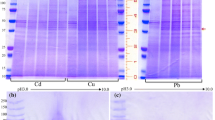Abstract
Organisms have evolved a cellular response called stress protein response that increases their tolerance in adverse environmental conditions. Well known stress proteins that bind essential and toxic metals are metallothionein (MT). The scallop Mizuhopecten yessoensis is the most interesting organism because it is able to accumulate toxic cadmium in its digestive gland. However, in the tissue of the digestive gland of Mizuhopecten yessoensis MT (metallothioneins) have not been found. Eastern scallops, Mizuhopecten yessoensis, were collected from two locations — one clean and one polluted site. The concentrations of cadmium (Cd), copper (Cu) and zinc (Zn) were measured in the digestive gland. There was a significant increase in Cd concentrations in this studied tissue. We found that in the presence of cadmium Mizuhopecten yessoensis can induce high molecular proteins. The results of experiments have shown that Cd-binding ligands have a number of properties similar to MT: acetone and temperature stability; the ability to bind some metals, including Cd, Cu and Zn. Protein chromatography (FPLC, Superosa 12) from the digestive gland of scallop M. yessoensis has shown that cadmium is associated with high molecular weight Cd-binding proteins (72 kDa and 43 kDa). The major cadmium-binding protein 72 kDa is glycoprotein. In experiments we have demonstrated that Cd-binding proteins can be induced when there is cadmium exposure. The results of this study strongly suggest that the far eastern scallop Mizuhopecten yessoensis has a unique and well-developed system for the detoxification of heavy metals and it allows for biochemical systems to be maintained in a relatively stable manner in the presence of heavy metals.
Similar content being viewed by others
References
Bebiano M, Serafim M, Rita M (1994) Involvement of metallothionein in cadmium accumulation and elimination in the clam Ruditapes decussata. Bull Environ Contam Toxicol 53:726–732
Bustamante P, Miramand P (2004) Interspecific and geographical variations of trace element concentrations in Pectinidae from European waters. Chemosphere 57:1355–1362
Dallinger R, Berger B, Hunziker PE (1993) Purification and primary structure of snail metallothionein. Similarity of the N-terminal sequence with histones H4 and H2A. Eur J Biochem 216:739–746
Dallinger R, Berger B, Gruber C, Stürzenbaum S (2000) Metallothioneins in Terrestrial Invertebrates: Structural Aspects, Biological Significance, and Implications for their Use as Biomarkers. Cell Mol Biol 46(2):331–346
Dohi Y, Ohba K, Yoneyama Y (1983) Purification and molecular properties of two cadmium-binding glycoproteins from the hepatopancreas of a whelk Buccinum tenuissimum. Biochim Biophys Acta 745:50–60
Dubois M, Gilles KA, Hamilton JK (1956) Colorimetric method for determination of sugars and related substances. Anal Chem 28:350–356
Giguere A, Coulliard Y, Campbell PGC (2003) Steady-state distribution of metals among metallothionein and other cytosolic ligands and links to cytotoxicity in bivalves living along a polymetallic gradient. Aquat Toxicol 64:185–200
Hamer DH (1986) Metallothionein. Ann Rev Biochem 55:913–951
Julshamn, Andersen K-J (1983) Subcellular distribution of major and minor elements in unexposed mollusks in western Norway-I. The distribution and binding of cadmium, zinc and copper in the liver and the digestive system of the oyster Ostrea edulis. Comp Biochem Physiol 75A:9–12
Kagi JHR, Kojima Y (1987) Chemistry and biochemistry of metallothionein: Metallothionein II. Basel, Birkhauser Verlag
Laemmli UK (1970) Cleavage of structural proteins during the assembly of the head of bacteriophage T4. Nature 5259:680–685
Lowry OH, Rosebrough NJ, Farr AL, Randall RJ (1951) Protein measurement with the Folin phenol reagent. J Biol Chem 193:265–275
Mackay EA (1993) Complete amino acid sequence of five dimeric and for monomeric forms of metallothionein from the edible mussel Mytilus edulis. Eur J Biochem 218:183–194
Metian M, Warnau M, Bustamante P (2007) Interspecific comparisons of Cd bioaccumulation in European Pectinidae (Chlamys varia and Pecten maximus). J Exp Mar Biol Ecol 353:58–67
Nolan CV, Duke EJ (1983) Cadmium accumulation and toxicity in Mytilus edulis: involvement of metallothioneins and heavy-molecular weight protein. Aquat Toxicol 4:153–163
Park J-S, Chung S, Park Il-S (2002) Purification and characterization of metallothionein-like cadmium-binding protein from Asian perwinkle Littorina brevicula. Comp Biochem Physiol C 131:425–431
Pavicic J, Raspor P, Martincic D (1993) Quantitative determination of metallothionein-like proteins in mussels: Methodlogical approach and field evaluation. Mar Biol 115:435–444
Petering DH, Fowler BA (1986) Discussion summary. Role of metallothionein and related proteins in metal metabolism and toxicity: Problems and perspectives. Environ Health Perspect 65:217–224
Ponzano E, Dondero E, Bouquegneau J-M, Sack R, Hunziker P, Viarengo A (2001) Purification and biochemical characterization of cadmium metallothionein from the digestive gland of the Antarctic scallop Adamussium colbecki (Smith, 1902). Polar Biol 24:147–153
Roesijadi G, Kielland S, Klerks P (1989) Purification and properties of novel molluscan metallothioneins. Archiv Biochem Biophys 273(2):403–413
Roesijadi G (1992) Metallothioneins in metal regulation and toxicity in aquatic animals (Review). Aquat Toxicol 22:81–114
Stone HC, Wilson SB, Overnell J (1986) Cd-binding proteins in the scallop Pecten maximus. Environ Health Perspect 65:189–191
Viarengo A, Canesi L, Massu-Cotelli A (1993) Cu, Zn, Cd content in different tissues of the Antarctic scallop Adamussium colbecki (Smith 1902): Role of metallothionein in the homeostasis and in the detoxification of heavy metals. Mar Environ Res 35:216–217
Author information
Authors and Affiliations
Corresponding author
Rights and permissions
About this article
Cite this article
Zhukovskaya, A.F., Belcheva, N.N., Slobodskova, V.S. et al. Metallothionein-like proteins induced by cadmium stress in the scallop Mizuhopecten yessoensis . Ocean Sci. J. 47, 189–195 (2012). https://doi.org/10.1007/s12601-012-0019-1
Received:
Revised:
Accepted:
Published:
Issue Date:
DOI: https://doi.org/10.1007/s12601-012-0019-1




